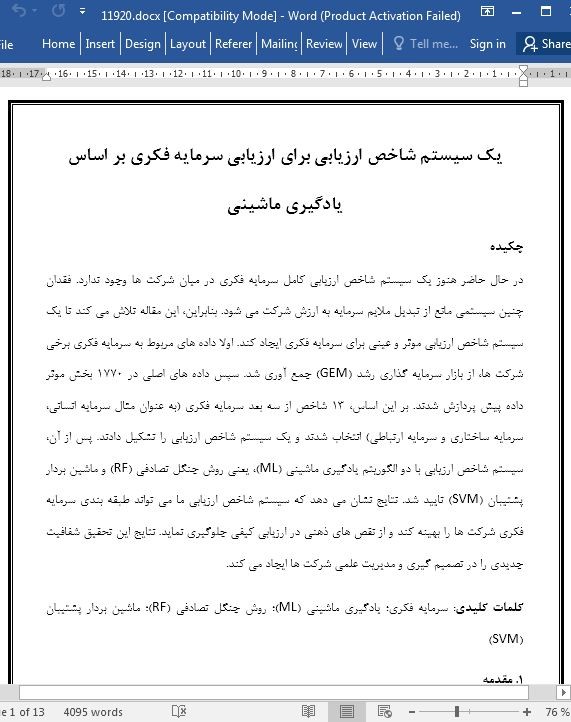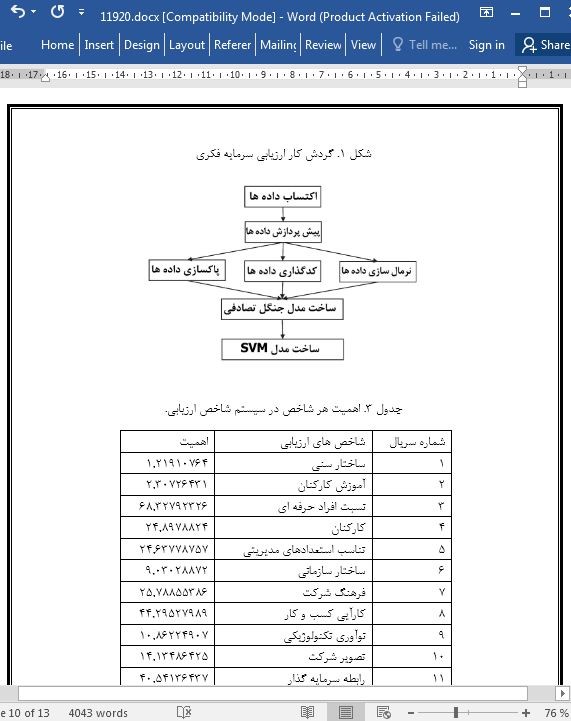
یک سیستم شاخص ارزیابی برای ارزیابی سرمایه فکری بر اساس یادگیری ماشینی
چکیده
در حال حاضر هنوز یک سیستم شاخص ارزیابی کامل سرمایه فکری در میان شرکت ها وجود ندارد. فقدان چنین سیستمی مانع از تبدیل ملایم سرمایه به ارزش شرکت می شود. بنابراین، این مقاله تلاش می کند تا یک سیستم شاخص ارزیابی موثر و عینی برای سرمایه فکری ایجاد کند. اولا داده های مربوط به سرمایه فکری برخی شرکت ها، از بازار سرمایه گذاری رشد (GEM) جمع آوری شد. سپس داده های اصلی در ۱۷۷۰ بخش موثر داده پیش پردازش شدند. بر این اساس، ۱۳ شاخص از سه بعد سرمایه فکری (به عنوان مثال سرمایه انسانی، سرمایه ساختاری و سرمایه ارتباطی) انتخاب شدند و یک سیستم شاخص ارزیابی را تشکیل دادند. پس از آن، سیستم شاخص ارزیابی با دو الگوریتم یادگیری ماشینی (ML)، یعنی روش جنگل تصادفی (RF) و ماشین بردار پشتیبان (SVM) تایید شد. نتایج نشان می دهد که سیستم شاخص ارزیابی ما می تواند طبقه بندی سرمایه فکری شرکت ها را بهینه کند و از نقص های ذهنی در ارزیابی کیفی جلوگیری نماید. نتایج این تحقیق شفافیت جدیدی را در تصمیم گیری و مدیریت علمی شرکت ها ایجاد می کند.
1. مقدمه
سرمایه فکری مانند حق ثبت اختراع، شرکت های دانش بنیان را قادر می سازد تا رقابتی باقی بمانند و آن ها را تشویق می کند تا نوآوری را دنبال کنند و در نتیجه ارزش آفرینی چنین شرکت هایی را ارتقا دهند [1]. علاوه بر این، سرمایه فکری پایه و اساس شرکت ها برای تدوین استراتژی های موثر در برابر شرایط اضطراری است. به عنوان مثال سرمایه رابطه ای و سرمایه ساختاری، دو بعد مهم سرمایه فکری هستند که می توانند برای کاهش ریسک های ناشی از تغییرات غیرقابل پیش بینی محیط و پاسخ به امور تجاری پیچیده و تصادفی مورد استفاده قرار گیرند. علاوه بر این، رقابت بین شرکت ها اساسا رقابت استعدادها است. یک شرکت برای باقی ماندن در رقابت باید از سرمایه انسانی، یک محرک فعال سرمایه فکری و ترکیب موثر سرمایه، مدیریت و نوآوری استفاده کند.
Abstract
Currently, there is not yet a mature evaluation index system of intellectual capital among enterprises. The lack of such a system hinders the smooth transform of capital to enterprise value. Therefore, this paper attempts to set up an effective and objective evaluation index system for intellectual capital. First, the data on intellectual capital were collected from some enterprises from the Growth Enterprise Market (GEM). Next, the original data were preprocessed into 1770 effective pieces of data. On this basis, 13 indices were selected from three dimensions (e.g. human capital, structural capital, and relationship capital) of intellectual capital, forming an evaluation index system. After that, the evaluation index system was verified with two machine learning (ML) algorithms, namely, random forest (RF), and support vector machine (SVM). The results show that our evaluation index system can optimize the intellectual capital classification of enterprises, avoiding the subjective defects in qualitative evaluation. The research results shed important new light on the decision-making and scientific management of enterprises.
1. Introduction
Intellectual capital, such as patents, enables knowledge-based enterprises to remain competitive and encourages them to pursue innovation, thereby promoting the value creation of such enterprises [1]. Besides, intellectual capital is the basis for enterprises to formulate effective strategies against emergencies. For example, relational capital and structural capital, two important dimensions of intellectual capital, can be utilized to mitigate the risks arising from the unpredictable changes of the environment, and to respond to the complex and stochastic business affairs. Moreover, the competition between enterprises is essentially the competition of talents. To remain competitive, an enterprise must fully leverage human capital, an active driver of intellectual capital, and effectively combine capital, management, and innovation.
چکیده
1. مقدمه
2. روش شناسی
2.1 طراحی سیستم شاخص ارزیابی
2.2 پیش پردازش داده ها
2.3 طبقه بندی RF
3. نتیجه گیری
منابع
Abstract
1. Introduction
2. Methodology
2.1. Design of evaluation index system
2.2. Data preprocessing
2.3. RF classification
2.4. SVM evaluation
3. Conclusions
References
- اصل مقاله انگلیسی با فرمت ورد (word) با قابلیت ویرایش
- ترجمه فارسی مقاله با فرمت ورد (word) با قابلیت ویرایش، بدون آرم سایت ای ترجمه
- ترجمه فارسی مقاله با فرمت pdf، بدون آرم سایت ای ترجمه



